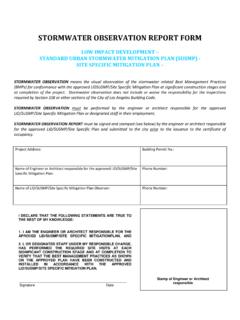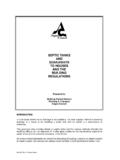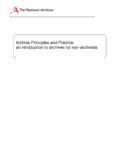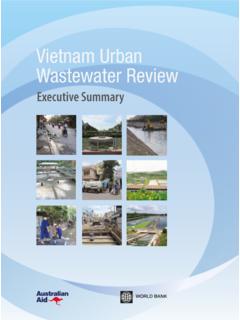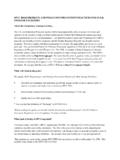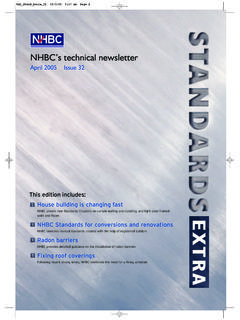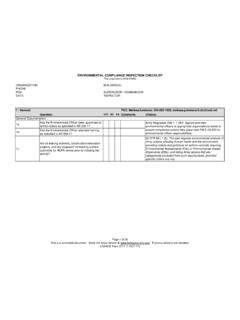Transcription of PLANNING AND LAND DEVELOPMENT …
1 PLANNING AND land DEVELOPMENT handbook . FOR LOW IMPACT DEVELOPMENT (LID). PART B. PLANNING ACTIVITES. May 9, 2016 5TH EDITION. THIS PAGE INTENTIONALLY LEFT BLANK. This 5th edition is a revision to the 4th edition to reflect the latest LID requirements as defined by the National Pollution Discharge Elimination System Permit (NPDES No. CASOO4001) and the City of Los Angeles Municipal Code. The handbook was originally created under the direction of the City of Los Angeles, who is fully responsible for the content within and a technical committee comprised of the Departments of PLANNING , Building and Safety, and Water and Power, the Bureaus of Street Services and Engineering, and individuals from the DEVELOPMENT , environmental, and consultant community. This DEVELOPMENT Best Management Practices handbook , Part B PLANNING Activities, 5th edition was adopted by the City of Los Angeles, Board of Public Works on May 9, 2016, as authorized by Section of the Los Angeles Municipal Code approved by Ordinance No.
2 183833. THIS PAGE INTENTIONALLY LEFT BLANK. TABLE OF CONTENTS. SECTION 1: 1. BACKGROUND .. 1. handbook PURPOSE AND SCOPE .. 2. LEGAL FRAMEWORK .. 2. DEVELOPMENT PLANNING PROGRAM .. 4. SECTION 2: PROJECT REVIEW AND PERMITTING PROCESS .. 6. PLAN APPROVAL PROCESS .. 6. INSPECTION PROCESS .. 10. BMP MAINTENANCE .. 10. MUNICIPAL PROJECTS .. 11. SECTION 3: STORMWATER MANAGEMENT MEASURES .. 12. GENERAL REQUIREMENTS .. 12. LOW IMPACT DEVELOPMENT (LID) PLAN ..12. HYDROMODIFICATIONS .. 16. SOURCE CONTROL MEASURE .. 19. SECTION 4: BMP PRIORITIZATION AND 21. PRIORITIZATION OF BMP SELECTION .. 21. INFILTRATION FEASIBILITY SCREENING .. 22. CAPTURE AND USE FEASIBILITY SCREENING .. 26. INFILTRATION 28. CAPTURE AND USE BMPS .. 39. HIGH EFFECIENCY BIOFILTRAION BMPS ..42. SECTION 5: OFFSITE MITIGATION MEASURES.
3 53. OFFSITE MITGATION 53. TABLE OF CONTENTS. APPENDICES. Appendix A DEVELOPMENT PLANNING Ordinances Appendix B Contact List Appendix C Small Scale Residential Plan Check Forms Appendix D All Other DEVELOPMENT Plan Check Review Forms Appendix E Small Scale Residential Prescriptive Measures Appendix F All Other DEVELOPMENT Sample Design Calculations Appendix G Source Control Measures Appendix H LA Department of Building and Safety Stormwater Infiltration Guidelines Appendix I Upper Los Angeles River Watermaster Requirements Appendix J County of LA Department of Public Health Policy and Operations Manual LIST OF TABLES. Table Summary of Source Control Measure Design Features Table Infiltration Feasibility Screening Table Infiltration BMP Design Criteria Table Biofiltration BMP Design Criteria Table Swale Base Width and Length (Per Unit Catchment Area).
4 Table Check Dam Spacing Requirements for Swales LIST OF FIGURES. Figure Small Scale Residential BMP Schematic Figure Requirements for Residential DEVELOPMENT of 4 Units or Less Figure Requirements for All Other Developments TABLE OF CONTENTS. ACRONYMS AND ABBREVIATION. BMP Best Management Practices BOE Bureau of Engineering BOS Bureau of Sanitation CGPL California General Plan Law CEQA California Environmental Quality Act CZARA Coastal Zone Act Reauthorization Amendments of 1990. C&A Covenant and Agreement DCP Los Angeles Department of City PLANNING EAF Environmental Assessment Form EIR Environmental Impact Report USEPA United States Environmental Protection Agency ESA Environmentally Sensitive Area ETWU Estimated Total Water Use CGPL California General Plan Law LADBS Los Angeles Department of Building and Safety LID Low Impact DEVELOPMENT MAWA Maximum Applied Water Allowance MND Mitigated Negative Declaration MS4 Municipal Separate Storm Sewer Systems NPDES National Pollutant Discharge Elimination System O&M Operation and Maintenance PCIS Plan Check and Inspection System RWQCB Los Angeles Regional Water Quality Control Board SOR Stormwater Observation Report SWRCB State Water Resources Control Board (California).
5 SUSMP Standard Urban Stormwater Mitigation Plan ULARA Upper Los Angeles River Area ULARWM Upper Los Angeles River Area Watermaster WPD Watershed Protection Division Section 1: Introduction |1. SECTION 1: INTRODUCTION. BACKGROUND. Urban runoff discharged from municipal storm drain systems has been identified by local, regional, and national research programs as one of the principal causes of water quality impacts in most urban areas. Urban runoff potentially contains a host of pollutants such as trash and debris, bacteria and viruses, oil and grease, sediments, nutrients, metals, and toxic chemicals. These contaminants can adversely affect receiving and coastal waters, associated biota, and public health. An epidemiological study by the Santa Monica Bay Restoration Project was conducted to investigate possible health effects of swimming in Santa Monica Bay.
6 Study results indicated that individuals swimming near flowing storm drain outlets have a greater risk of developing various symptoms of illnesses compared to those swimming 400 yards away from the same drains. In addition, oil and grease from parking lots, leaking petroleum or other hydrocarbon products, leachate from storage tanks, pesticides, cleaning solvents, and other toxic chemicals can contaminate stormwater and be transported downstream into water bodies and receiving waters. Fertilizer constituents from lawns and golf courses or leaking septic tanks can cause algal blooms. Disturbances of the soil from construction can allow silt to wash into storm channels and receiving waters, making them muddy, cloudy, and inhospitable to natural aquatic organisms. Heavy metals are toxic to aquatic organisms and many artificial surfaces of the urban environment such as galvanized metal, paint, or preserved wood containing metals contribute to stormwater pollution as the surfaces corrode, flake, dissolve, or decay.
7 land DEVELOPMENT and construction activities significantly alter drainage patterns and contribute pollutants to urban runoff primarily through erosion and removal or change of existing natural vegetation. When homes, shops, work places, recreational areas, roads, parking lots, and structures are built, increased flows are discharged into local waterways. As the amount of impervious surface increases, water that once percolated into the soil now flows over the land surface. Accordingly, increases in impervious surfaces can increase the frequency and intensity of stormwater flows through a watershed. Flow from rainstorms and other water uses wash rapidly across the impervious landscape, scouring the surface of various kinds of urban pollutants such as automotive fluids, cleaning solvents, toxic or hazardous chemicals, detergents, sediment, metals, bacteria, pesticides, oil and grease, and food wastes.
8 These pollutants, unfiltered and unfettered, flow through stormwater infrastructure and ultimately contaminate receiving waters. CITY OF LOS ANGELES LOW IMPACT DEVELOPMENT BEST MANAGEMENT PRACTICES handbook . Section 1: Introduction |2. handbook PURPOSE AND SCOPE. The purpose of this handbook is to assist developers in complying with the requirements of the DEVELOPMENT PLANNING Program regulations of the City's Stormwater Program. This handbook summarizes the City's project review and permitting process, identifies stormwater mitigation measures, and references source and treatment control BMP information. It provides guidance for individuals involved in new DEVELOPMENT and redevelopment projects. The target audience for this handbook includes developers, designers, contractors, homeowners, and City staffs that are engaged in plan-checking, permitting, and inspections related to land DEVELOPMENT activities.
9 This handbook also contains the necessary forms and worksheets required to be completed by the developer for approval. LEGAL FRAMEWORK. With public concern growing over urban runoff and stormwater pollution, local, state, and federal agencies have devised plans to control and/or treat stormwater-related pollution before it reaches receiving waters. The Federal Clean Water Act is the principal vehicle for control of stormwater pollution. Under the Federal Clean Water Act, each municipality throughout the nation is issued a stormwater permit through the National Pollutant Discharge Elimination System (NPDES) program. The primary goal of each permit is to stop polluted discharges from entering the storm drain system and local receiving and coastal waters. In California, the NPDES stormwater permitting program is administered by the State Water Resources Control Board (SWRCB) through its nine Regional Boards.
10 On Nov 8, 2012, the Los Angeles Regional Water Quality Control Board (Regional Board or RWQCB) adopted Order No. RA-2012-0175 the NPDES Stormwater Permit (Permit) for the County of Los Angeles and cities within (NPDES No. CAS004001). The Permit was issued to Los Angeles County Flood Control District, the county of Los Angeles, and 84 incorporated cities within the coastal watersheds of Los Angeles County to reduce pollutants discharged from their Municipal Separate Storm Sewer Systems (MS4) to the Maximum Extent Practicable (MEP). statutory standard. On December 28, 2012 the Order became effective. The requirement to implement the Permit is based on federal and state statutes, including Section 402(p) of the Federal Clean Water Act, Section 6217 of the Coastal Zone Act Reauthorization Amendments (CZARA) of 1990, and the California Water Code.

